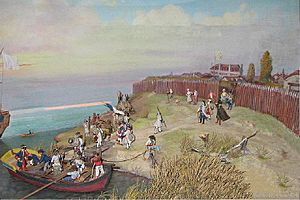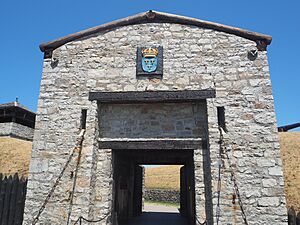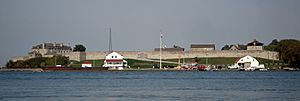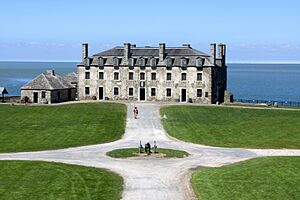Fort Niagara facts for kids
|
Fort Niagara
|
|

View of French Castle at Fort Niagara
|
|
| Location | Fort Niagara State Park, Porter, Niagara County, New York, US |
|---|---|
| Nearest city | Youngstown, New York |
| Area | 250 acres (100 ha) |
| Built | 1726 |
| NRHP reference No. | 66000556 |
Quick facts for kids Significant dates |
|
| Added to NRHP | October 15, 1966 |
| Designated NHL | October 9, 1960 |
| Fort Niagara | |
|---|---|
| Youngstown, New York | |

Fort Niagara 1728
|
|
| Type | Trading Post |
| Site information | |
| Controlled by | France 1678–1759 Great Britain 1759–1796 U.S. Army 1815–1963 U.S. Coast Guard 1963–present |
| Site history | |
| Built | 1678 |
| In use | 1726–present |
| Battles/wars | French and Indian War
Bradstreet's Expedition The War of 1812 |
| Garrison information | |
| Past commanders |
Louis-Thomas Chabert de Joncaire (1720–1726) John W. Heavey (1916–1917) |
Fort Niagara, also known as Old Fort Niagara, is a historic fort in Youngstown, New York. It was first built by New France to protect its interests in North America. The fort was important for controlling who could travel between the Niagara River and Lake Ontario. Lake Ontario is the easternmost of the Great Lakes.
The fort sits on the eastern bank of the Niagara River, right where it meets Lake Ontario. The British took control of the fort in 1759 during the French and Indian War. After the American Revolutionary War, the United States was supposed to get the fort. However, the British stayed until 1796. This transfer happened after the Jay Treaty was signed, which set the border with British Canada.
The U.S. Army stopped using the fort in 1963, but the U.S. Coast Guard still has a presence there today. A non-profit group now manages the fort and its grounds as a state park. It serves as a museum and a place for historical re-enactments. It also hosts special events about the region's history.
Contents
Building Fort Niagara
The very first fortified building was constructed in 1678 by René-Robert Cavelier, Sieur de La Salle. It was called Fort Conti. Later, in 1687, the Governor of New France, the Marquis de Denonville, built a new fort. He named it Fort Denonville. He left a hundred soldiers there, but most of them died from harsh winter weather and sickness. Because of this, the fort was abandoned in 1688.
Years later, in 1720, Louis-Thomas Chabert de Joncaire asked the Seneca people for permission to build a French post. The Seneca were one of the Iroquois League nations. Since Joncaire had lived with the Seneca before, they agreed to let him build a dwelling. Joncaire and his men then built a trading post called Magasin Royal or Maison de la Paix. These names meant "Royal Store" or "House of Peace." The French wanted to show they intended to trade peacefully for furs.
In 1726, a French engineer named Gaspard-Joseph Chaussegros de Léry built a two-story building. It was called a Maison à Machicoulis, or "Machicolated House." This building replaced the older fort. In 1755, the French made the fort even bigger. This was because of growing conflicts between French and British colonists. These conflicts were part of a larger war in Europe called the Seven Years' War. In North America, it was known as the French and Indian War. Both sides sought help from Native American allies.
The name "The French Castle," which is used today, did not become popular until the 1800s.
British and American Control
Fort Niagara was a very important location during the French and Indian War. The British captured it in July 1759 after a nineteen-day attack called the Battle of Fort Niagara. The French commander, Pierre Pouchot, surrendered the fort to the British leader, Sir William Johnson.
The British controlled the fort for 37 years. Even though the Treaty of Paris gave Fort Niagara to the United States after the American Revolutionary War, the British stayed. American forces finally took control in 1796 after the Jay Treaty was signed.
During the War of 1812, the fort's cannons sank a British ship called the Seneca in November 1812. British forces then captured the fort on December 19, 1813. This was in response to American forces burning the nearby town of Niagara. The British held the fort until the Treaty of Ghent ended the war. Since then, it has remained under U.S. control.
Later Uses of the Fort
The name "Old Fort Niagara" helps people tell it apart from a newer fort built nearby. After the American Civil War, a "New Fort Niagara" was constructed outside the original fort's walls. This new fort was built in a more modern style, like a military camp. This was because older stone forts were not as effective against new, powerful cannons.
The new Fort Niagara had a long rifle range and good access to train lines. It was also close to the industrial areas of Niagara Falls and Buffalo, New York. Soldiers trained at Fort Niagara for the Spanish–American War. In June 1917, as the United States prepared for World War I, the fort started an officer training school.
During World War II, Fort Niagara was first a place where new soldiers joined the army. Later, it became a prisoner of war camp for about 1,200 German soldiers. After the war, the fort offered temporary homes for soldiers returning from service.
During the Korean War, the fort served as a base for anti-aircraft artillery and later for Nike missiles. The United States Coast Guard still operates at a part of the site called "The Bottoms." Fort Niagara is considered one of the longest continuously used military bases in the United States. It has been used from French control in 1726 to the present day.
In 1931, a group called the Old Fort Niagara Association began to preserve and operate the fort. In 1960, the fort was recognized as a National Historic Landmark. This means it is a very important historical site in the United States.
Fort Niagara Today
Today, the renovated Fort Niagara is part of Fort Niagara State Park and a museum. It often hosts exciting historical re-enactments of 18th-century battles. You can also see period dances, fundraisers, and other special events there. These events teach visitors about the fort's history and the surrounding area. Fort Niagara is also known as the Old Fort Niagara State Historic Site.
The fort was officially named a National Historic Landmark on October 9, 1960. The area around it, called the Colonial Niagara Historic District, was added to the National Register of Historic Places in 1966. It is a key part of the Niagara Falls National Heritage Area.
Haunting Legend
Some people believe that the fort is haunted by a headless French soldier. The story says he lost his head during a duel and now wanders the grounds, searching for it.
See also
- Military of New France
- List of French forts in North America
- List of National Historic Landmarks in New York
- List of New York State Historic Sites
- Fort Erie National Historic Site – another fort at the start of the Niagara River
- Fort George National Historic Site – across from Fort Niagara in Ontario
- Fort Mississauga – also across from Fort Niagara, on the Ontario side







